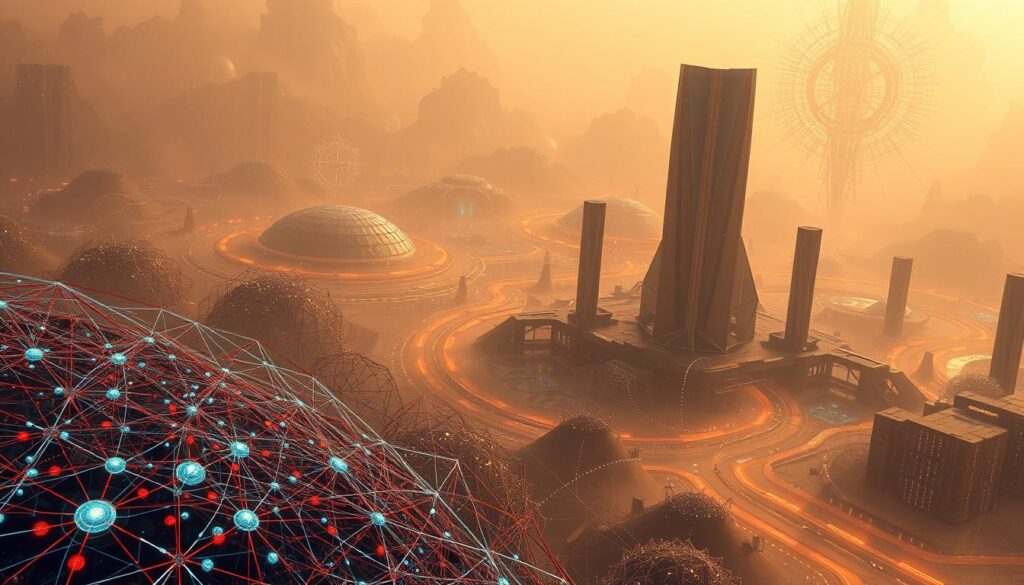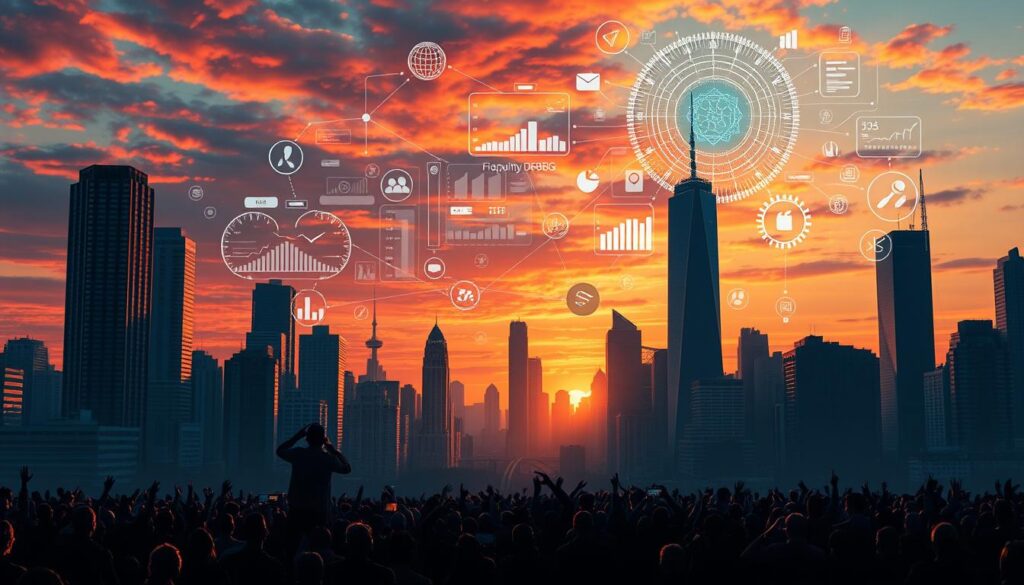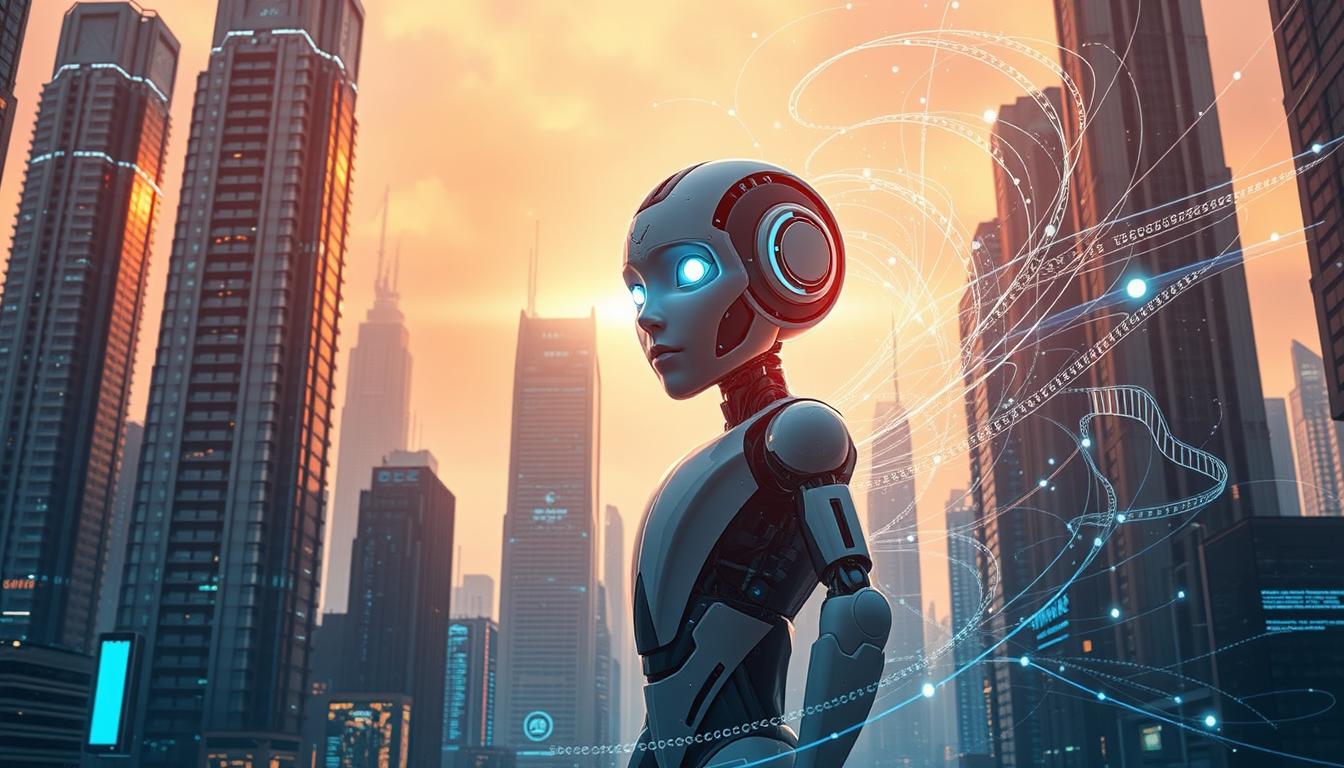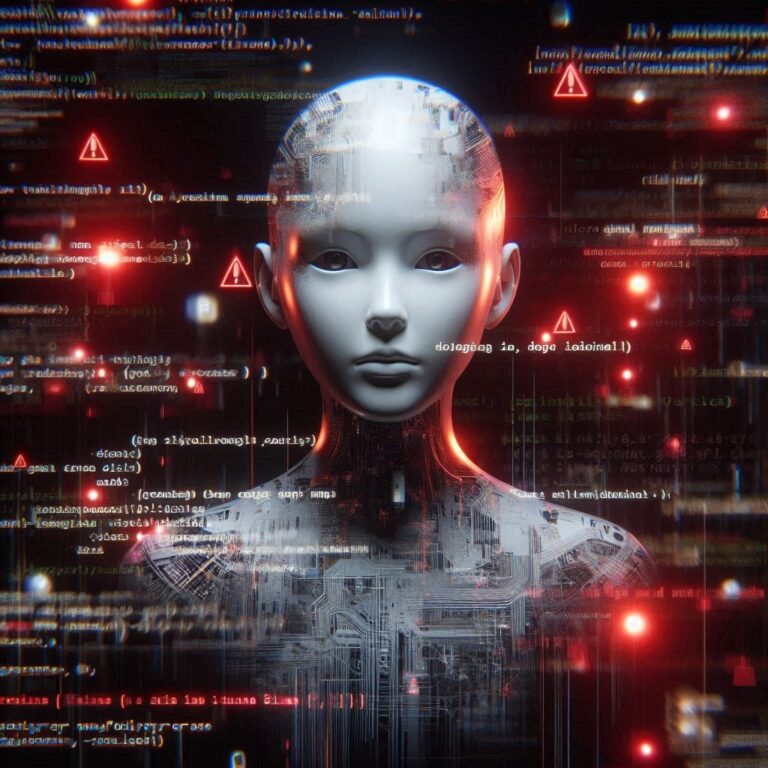Generative AI: Shaping the Future of Technology
Artificial intelligence is changing the tech world, with machine learning at its heart. Generative AI is leading this change. It uses machine learning to open up new possibilities for how we live and work.
Generative AI is built on artificial intelligence and machine learning. These technologies help create systems that can learn and grow. This field is exciting and growing fast, promising big changes for both industries and individuals.
Introduction to Generative AI
Generative AI is changing how we use technology. It’s making new ways to create content and do scientific research. This is all thanks to machine learning and artificial intelligence.
As we dive into generative AI, we’ll see its importance and how it will change our lives. Artificial intelligence and machine learning are key to its success.
Key Takeaways
- Generative AI is a subset of artificial intelligence that leverages machine learning to create new possibilities.
- Artificial intelligence and machine learning are foundational to generative AI, driving innovation and growth.
- Generative AI has the potential to transform industries and revolutionize the way we live and work.
- Machine learning is a critical component of generative AI, enabling the creation of complex systems that can learn and adapt.
- Generative AI is poised to shape the future of technology, with applications in creative content generation, scientific research, and more.
- Artificial intelligence and machine learning will continue to play a crucial role in the development of generative AI.
Understanding Generative AI: The Basics
Generative AI lets machines create new stuff like images, videos, and text. It’s getting a lot of attention because it could change many industries. At its heart, it uses deep learning and neural networks to spot patterns and make new content.
To get how generative AI works, we need to look at its main parts and setup. Some key things include:
- Neural networks: These are the core of generative AI. They help machines learn and show complex data patterns.
- Deep learning: This part of machine learning lets neural networks get better over time. This way, they can make high-quality content.
- Data: Generative AI needs lots of data to learn and create new stuff. So, having good data is very important for it to work well.
Recent AI research has made generative AI a lot better. For example, neural networks can now make images and videos that look real. Also, deep learning has made the text generated by AI more clear and smooth.
As generative AI keeps getting better, it’s key to know its main tech and parts. This way, we can see all its possibilities and use it in many fields.
The Evolution of Generative AI Technology
Generative AI technology has grown a lot since it started. It uses natural language processing to understand and create human-like language. This has improved chatbots and language translation a lot.
Computer vision is also key in generative AI. It lets AI systems understand and make visual data, like images and videos. It’s used in self-driving cars, facial recognition, and medical diagnosis.

- Development of recurrent neural networks (RNNs) for natural language processing
- Introduction of generative adversarial networks (GANs) for computer vision tasks
- Creation of large language models like transformer and BERT
These steps have led to more advanced AI uses. Now, we see AI in content creation, data analysis, and making decisions.
As generative AI technology keeps getting better, we’ll see even more cool uses in the future.
Current Applications Transforming Industries
Generative AI is changing many industries, making businesses work better and opening new chances for growth. It’s especially changing content creation, helping companies make great content fast. This is big for marketing, ads, and media, where making content is key.
In research automation, generative AI helps scientists look through lots of data. It finds patterns humans might miss. This is leading to big discoveries in medicine, space, and climate science.

- Healthcare: It’s helping create new treatments and medicines, and improving patient care.
- Finance: It’s spotting fraud and creating new financial models.
- Education: It’s making learning plans for each student and new educational materials.
Generative AI is making a big difference in many areas. It’s helping businesses and groups work better. As it keeps getting better, we’ll see even more cool uses of generative AI.
How Generative AI Works Behind the Scenes
Generative AI uses algorithmic processes to learn from big datasets. It analyzes data to find patterns and relationships. Then, it uses this knowledge to create new, unique content.
The secret to generative AI’s success is its ability to learn from lots of data. It uses deep learning and neural networks to spot patterns humans might miss. This lets it make new content that looks and feels like the original.
Here’s how generative AI operates in secret:
- It processes and analyzes big datasets to find patterns and relationships.
- It uses algorithmic processes to make new content based on what it finds.
- It keeps getting better through data analysis and feedback.
Understanding how generative AI works helps us see its complexity and power. It opens up new ways to use it in different fields and industries.
The Impact on Business and Economy
Generative AI is changing the business world and economy. Studies show it will bring new opportunities and challenges. It will help industries grow, work better, and save money.
But, there’s a big worry about job displacement. As AI takes over, some jobs might disappear. Yet, new jobs will likely pop up, needing skills that work with AI.

- Market transformation: It will help businesses make new products and services. This will change market trends and how people shop.
- Job market evolution: AI will automate some jobs. Workers will need to learn new skills to work with AI.
- Economic implications: AI’s wide use will affect the economy. It will change how we work, earn, and spend.
The effects of generative AI on business and economy will be big. It will bring good and bad changes. As AI grows, everyone needs to understand its impact. We must work together to make sure it helps us all.
Ethical Considerations and Challenges
As generative AI gets better, we must think about its ethics. A big worry is privacy concerns. AI needs lots of personal data to work well. This makes us question how our data is protected and if we gave consent.
Another big issue is bias mitigation. AI can make old biases worse if it’s not made fairly. This is a big problem in healthcare, education, and law enforcement.
To solve these problems, we need strong ethical rules for AI. We must make sure AI is open and fair. We also need ways for people to give feedback and get help.

- Use strong data protection and privacy rules
- Make AI algorithms fair and clear
- Keep training AI developers and users
- Set clear rules for AI use
The Role of Generative AI in Innovation
Generative AI is changing how we innovate, speeding up innovation acceleration and making technology accessibility possible. It lets researchers and developers explore new ideas quickly.
In research and development, generative AI is a game-changer. It helps find new materials, medicines, and technologies fast. Here are some ways it’s used:
- Simulating complex systems and predicting outcomes
- Creating new molecular structures for drug discovery
- Developing unique materials
Generative AI also makes technology available to more people. This includes entrepreneurs, small businesses, and individuals who couldn’t develop new tech before.
As generative AI gets better, we’ll see more innovation. It’s set to change how we live and work, speeding up innovation acceleration and making technology accessibility better.
Integration with Existing Technologies
Generative AI is getting better and better. It’s now working well with other technologies. For example, it’s great with cloud computing. This lets us use AI models easily and manage them well.
Cloud computing helps AI work faster with big data. This makes AI apps smarter and more useful.
Generative AI also works well with the Internet of Things (IoT). IoT devices send a lot of data. AI can understand this data and make smart choices quickly.
Integrating AI with other tech has many benefits. It makes things more flexible and scalable. It also helps us analyze data better and work more efficiently.
- Enhanced scalability and flexibility
- Improved data analysis and interpretation
- Increased automation and efficiency
By using cloud integration and IoT applications, AI can help us innovate more. It’s changing many industries and how we live and work.
The Human Factor: Collaboration Between AI and Humans
Exploring generative AI’s potential, we must consider the human aspect. Human-AI collaboration is key to unlocking this technology’s full potential. Together, humans and AI can boost productivity and efficiency.
Research shows human-AI teamwork brings many benefits. For example, AI can sift through huge data sets, uncovering insights humans might overlook. Meanwhile, humans can add context and judgment, making AI’s decisions more informed and responsible.
To make human-AI collaboration work, we need the right skills and mindset. It’s important to know what AI can and can’t do. Also, we must learn to communicate well with AI. This way, we can make the most of workforce augmentation, leading to a more efficient team.
Some key advantages of working together with AI include:
- Improved decision-making
- Enhanced creativity
- Increased productivity
- Augmented workforce
By embracing human-AI collaboration, we can unlock AI’s full potential. This drives innovation and growth across industries. As we progress, focusing on developing the necessary skills and mindset is crucial. This ensures we benefit from AI while managing its risks.
Future Predictions and Trends
Looking ahead, generative AI will be key in many industries. It can learn, adapt, and get better. This makes it a game-changer for healthcare, finance, and education.
New trends in generative AI include better image and speech recognition. It also involves more advanced natural language processing. These changes will help generative AI in more areas, like virtual assistants and self-driving cars.
Emerging Applications
- Personalized medicine and healthcare
- Intelligent tutoring systems
- Autonomous vehicles and drones
Experts predict big leaps in generative AI tech soon. We’ll see more powerful and efficient algorithms. This will lead to advanced future applications, like virtual reality and smart robots.
Technology Roadmap
The future of generative AI depends on progress in computer vision, natural language processing, and reinforcement learning. As these areas grow, we’ll see more creative uses of generative AI.
Conclusion: Embracing the Generative AI Revolution
We’ve explored how generative AI is changing the game. It’s on the verge of a big change that will affect many areas. Embracing this change and adopting AI will be key to unlocking its full power.
Generative AI is set to speed up scientific breakthroughs and change how we create. It will blend with current tech, opening up new possibilities. As we move forward, we must be innovative, work together, and use it wisely.
The future of generative AI looks bright, and it’s time to dive in. By staying up-to-date and open, we can make the most of it. This journey might face hurdles, but the benefits will change our world for the better.
FAQ
What is generative AI?
Generative AI is a type of artificial intelligence that can make new content. This includes text, images, audio, or even code. It uses deep learning and neural networks to create original and realistic stuff.
How does generative AI work?
Generative AI models are trained on huge amounts of data. This data can be text, images, or audio. They learn patterns and structures in this data using advanced algorithms.
When given a new prompt, they can create new content. This content looks like it came from the training data.
What are some common applications of generative AI?
Generative AI is used in many areas. It helps in creating content like writing, music, and art. It also aids in scientific research, business, and healthcare.
It automates tasks, boosts productivity, and opens up new possibilities. This technology is changing many industries for the better.
What are the ethical considerations with generative AI?
Generative AI raises concerns about privacy, bias, and transparency. It’s important to develop these technologies responsibly. We need to ensure they benefit society and don’t cause harm.
Addressing data privacy, bias, and the need for human oversight is key. This will help us use generative AI ethically.
How is generative AI integrated with other technologies?
Generative AI works well with technologies like cloud computing and the Internet of Things (IoT). These combinations make data processing faster and decision-making quicker.
They also allow generative AI models to work on different devices smoothly. This boosts their capabilities and uses.
What is the role of humans in the future of generative AI?
Humans and AI systems need to work together for generative AI to grow. Humans provide oversight and domain expertise. They ensure these technologies are used ethically.
As generative AI becomes more common, the workforce will need to change. New skills focused on human-AI collaboration will become very important.







One Comment